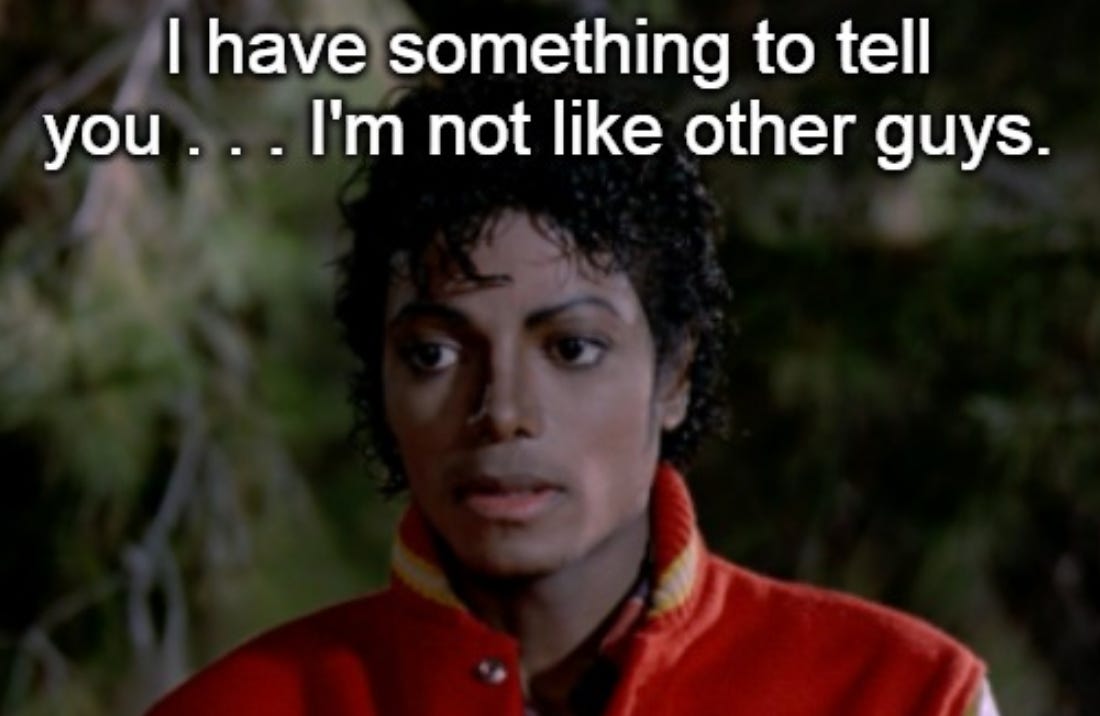This 1 simple trick will make you way better at teaching math
Stop making things worse with the way you talk
This post is dedicated to math-teaching podcasters Pam Harris and Kim Montague, whose pod finally got me to pay more serious attention to the issue of psychological transparency in math language. My recommendation of their podcast was my very first newsletter.
It’s become a bit of a meme to point to several ways that the English language is (supposedly) not terrific at making math psychologically transparent to listeners.
The idea that the specific linguistic features in question are particularly important in the big picture is not overwhelmingly convincing to your author.1
BUT: These examples do us a favor. Namely, they drive home the subtle ways in which your words have the power to illuminate or obscure.
My goal: Language doesn’t wield you. YOU wield language.
In other word: Changing how you talk about math is one of the highest ROI things you can do to help your kids.
My goal: Language doesn’t wield you. YOU wield language.
How language can make math more or less clear
Skip ahead, linguistics nerds for whom this is old news.
The most frequent example I’ve heard cited is between the English and Mandarin words for numerals.
The (niche) famous issue is: In English, our numerals have some…irregularities.
Consider: The English words for 11…19 don’t follow the pattern of either 1-9 or 21+. And the words for numbers that are multiples of ten (ten, twenty, thirty, etc.) don’t say clearly what they are. At least, not as clearly as if we said: “one-ten (10), two-tens (20), three-tens (30), four-tens (40).”
In contrast, here’s what Mandarin does (h/t BBC):
In Chinese, the number words lack these irregularities. Once you know the words for one through 10, you can easily infer all the others.
For example, the word for one is yi, two is er, and ten is shi. Eleven is shi yi (ten-one), twelve is shi er (ten-two) etc. Twenty is er shi (two-ten), twenty-one is er shi yi (two-ten-one). This consistent characteristic is known as linguistic transparency by psychologists, and it was long thought to aid children's first steps to basic numeracy.
Fractions offer another (less commonly cited) example of how language can be better or worse at mathematical transparency is. Here’s BBC helping us understand what is going on in Korean vs. English fraction talk:
Even if the influence of language does not extend to the whole of mathematics, emerging evidence suggests it might extend to a handful of skills beyond counting. So far, there is some evidence that language may affect how quickly children learn to use fractions. “When thinking about fractions, we have to look at the big part first and then see how much of that is in the numerator,” explains Jimin Park at the University of Minnesota, whose PhD thesis concerns the linguistic representation of fractions.2
In Korean, this relationship is explicitly spelled out. The term for 1/3 is sam bun ui il, which translates as “of three parts, one”, and 3/7 is chil bun-ul sam, which translates as “of seven parts, three” – where the English terms “one third” or “three sevenths” do not make this so immediately obvious. And this seems to give young Korean children a slight advantage in matching named fractions to diagrams illustrating the quantity, before they have even been taught formal lessons in the idea. “When they have to verbally understand fractions, the Korean children definitely benefit,” says Park. Intriguingly, when English children are taught to describe fractions with the Korean style of phrasing, it does seem to improve their intuitive understanding of the quantities. [Emphasis added]
1 simple trick to break the bonds of linguistic determinism
So what’s a parent to do knowing that words aren’t always fit for purpose?
Unfortunately, not all of you have the option (like my tiger dad reader who texted in Saturday) to send your kid to Mandarin immersion school.
Just kidding, I don’t in fact think this issue is specific to one language like English!
So, consider my family’s approach: “Transparency by belt and suspenders” (working title). Not rocket science, just… use multiple strategies and repetition to increase the likelihood that your speech is clear (what experts call “linguistically transparent”).
Use multiple strategies and repetition
to increase the likelihood that your speech is clear
(what experts call “linguistically transparent”)
What I mean is, when you talk about math, build a habit of always using two or three ways to say the same thing until your kid’s ownership of the concept and standard jargon is rock solid.3
Example: Instead of “2 + 3 equals 5”
Say “2 + 3 equals 5, meaning 2 + 3 is the same as 5”
Example: Instead of “What is five times four?”
Say: “What is five times four? I mean four fives, which is the same as five fours.” And add for the newest conversations on the topic… “That’s five plus five plus five plus five.”
Example: Instead of “What’s one quarter of 100?”
Say: “What’s one quarter of 100? That’s one ‘one fourth’ of a hundred. A “one fourth” of one hundred is the same as if you divided that 100, say, strawberries4 , into four equal piles.”
Example: Instead of “5 times x is 25”
Say: “5 times x is 25. Or, 5 ‘whats’ make 25.”
Tips
One of the ways you label things should almost always be one or two of the standard phrases they will hear.5 Example: I don’t usually say a nontraditional phrase like “one ‘one fourth’” to my kids without also saying “a fourth, which is the same as a quarter.” They need to be able to comprehend and code switch to trad math talk out there in the world :-) And, chances are, you and any co-parent will be defaulting back to trad math talk all the time without realizing it, no matter how mindful you are.
When you’re coming up with your way of talking about things: Think about decomposing a concept into smaller building blocks that are more familiar. So, with the fraction example, “three quarters,” you might decompose first into first into phrases that explain “what is ‘a quarter’?” and then add on phrases that explain how to add up three of those.
If you find it hard to use multiple transparent language options in an area of math (say, ratios and fractions), it could mean you don’t own the math itself well enough yet. Based on readers writing in, I know you all start from a wide range, from math nerd to math-frustrated. Not to sound like a broken record, but firing up Pam Harris and Kim Montague’s Math is Figure-Out-Able podcast is like hiring a (free!) pair of math doulas who will help usher forth a new era for you and your kid.
But also, don’t hide the other ball
I’ll talk more about this in a later post, but: A related issue I’m passionate about is not being under-ambitious about teaching standard mathematical terms and notation.
Example: You might have seen math materials for early grades using a structure like: “5 + ___ = 10,” rather than 5 + x = 10. Or 5 x ____ = 25 instead of 5x = 25. And so on.
My take: Many (most?) kids are ready for the standard mathematical lexicon and notation a LOT quicker than you and their teachers might be assuming. I don’t see any harm in introducing it from the very beginning, say, age 3. (That’s what we do with my kids and they don’t bat an eyelash.)
There’s a reason society use standard mathematical terms and notation. It’s just more efficient.
Moreover, using standard terms and notation will unlock your kid’s ability to use apps or textbooks that are designed for older kids and adults. That can be helpful when you max out on say, the Khan Academy Kids and need to graduate little Romulus and Remus to the Khan Academy adult learning app.
Using standard terms and notation
will unlock your kid’s ability to use apps or textbooks
that are designed for older kids and adults
(BUT: When introducing visual or linguistic jargon, don’t forget to use the brute force method I outlined above - i.e., “say (or notate) everything 2 or 3 ways,” with some of those ways being as linguistically transparent as you can manage, for a while until your kid owns it. ) ●
Previously on The Home School…
If you’re all done fixing how you talk about math with your kids, why not check out some of my previous math posts:
Don’t click if you feel great about how to teach your kids math (an impassioned recommendation for the free math podcast that changed my (parenting) math life)
This iPad math game might just change your relationship to screens (a love letter to one of the best games that allows me to delegate math teaching to a screen)
5 perfect holiday kid gifts (featuring, among other things, one gorgeous and pedagogically sound math present under $20 suitable for most of your Christmas/Hanukkah list)
Because… language is not a series of individual LEGO bricks that can be QA’d well in isolation. Also, I think we should at least consider that the examples used (certain examples of more psychologically transparent math concepts in a few Asian languages) might be percolating to the surface of cultural because they appear to confirm underlying stereotypes and or trigger western audience’s anxieties about competition with Asian culture in the realm of STEM.
Not sure I’d go with “big part,” Professor Park, but that’s another story… I’d like to hear why they went with that term.
Should I call this transparency by triplicate?
I’d say pennies, but let’s be honest, this readership’s children are much more familiar with berries than they are with pennies.
I’m curious of folks’ takes on this. I’ve heard the Math-Is-Figureoutable take issue with specific English turns of phrase “one over four” for 1/4, and suggest not using them at all (IIRC). I’m predisposed to see any label as good to use if accompanied by good enough context through the “transparency in triplicate” approach.





